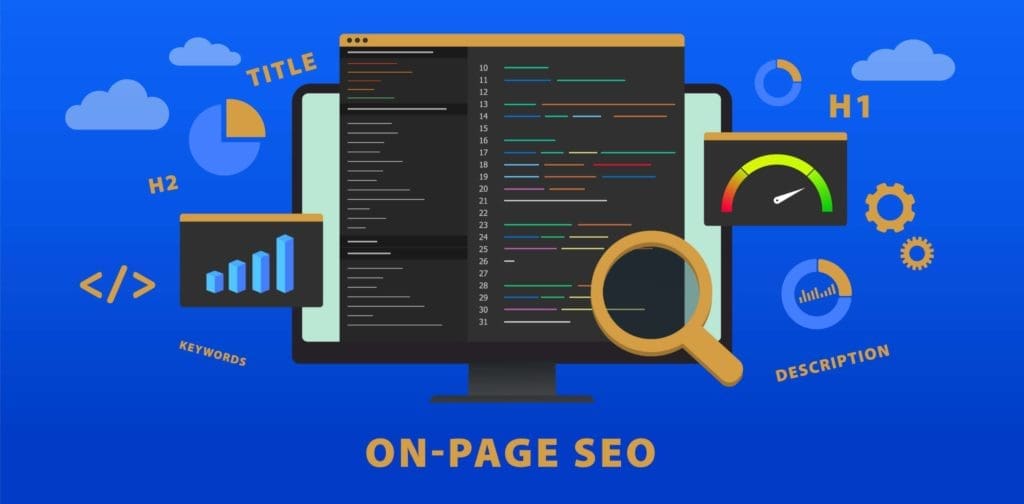[vc_row row_height_percent=”0″ override_padding=”yes” h_padding=”2″ top_padding=”3″ bottom_padding=”2″ overlay_alpha=”50″ gutter_size=”3″ shift_y=”0″][vc_column column_width_percent=”100″ position_vertical=”middle” align_horizontal=”align_center” gutter_size=”3″ overlay_alpha=”50″ shift_x=”0″ shift_y=”0″ z_index=”0″ medium_width=”0″ width=”1/1″][vc_custom_heading heading_semantic=”h1″ text_size=”h1″ uncode_shortcode_id=”984822″]
ULTIMATE GUIDE TO SEO FOR THE LEGAL SECTOR
[/vc_custom_heading][vc_row_inner][vc_column_inner width=”1/3″][vc_button wide=”yes” link=”url:%23architecture|||”]Site Architecture[/vc_button][/vc_column_inner][vc_column_inner width=”1/3″][vc_button wide=”yes” link=”url:%23content|||”]Content Overlap[/vc_button][/vc_column_inner][vc_column_inner width=”1/3″][vc_button wide=”yes” link=”url:%23onpage|||”]On-Page SEO[/vc_button][/vc_column_inner][/vc_row_inner][vc_row_inner][vc_column_inner width=”1/3″][vc_button wide=”yes” link=”url:%23technical|||”]Technical Optimisation[/vc_button][/vc_column_inner][vc_column_inner width=”1/3″][vc_button wide=”yes” link=”url:%23authority|||”]Build Authority[/vc_button][/vc_column_inner][vc_column_inner width=”1/3″][vc_button wide=”yes” link=”url:%23brand|||”]Building Your Brand[/vc_button][/vc_column_inner][/vc_row_inner][vc_row_inner][vc_column_inner width=”1/1″][vc_column_text el_class=”ultimate-guides-font-size” uncode_shortcode_id=”262058″]

Why is SEO for the legal sector important?
The legal market is a mix of B2B and consumer products and services. Some cost a few hundred pounds, others starting in the millions. If there is one theme that ties these variables together it’s that buyers need to feel like they have thoroughly researched.
And more often than not, that research process will involve (and often start with) a search into Google.
To be clear, that is not to suggest that the enquiry will directly follow such a search query. In fact, this is one of the most important things to understand about SEO in the legal industry – it’s as much about the research phase as it is about the conversion phase. We refer to this as “top of funnel” content marketing.
The reason this is so important is that when an enquiry is made, there have usually been 5-10 touch points already established between the brand and the buyer. So while it may not appear to have originated from a search query (Google analytics may instead track it as a direct visit or from some other source, such as social), SEO may nevertheless have played a critical role in the journey. On the other hand, if they only find you in their final “bottom of funnel” search query, they’re unlikely to have the trust required in your brand and will enquire instead with one of the 3 other brands they have open on separate tabs.
This Ultimate Guide to SEO for the legal sector will help explain why SEO should be at the cornerstone of your strategy.[/vc_column_text][/vc_column_inner][/vc_row_inner][/vc_column][/vc_row][vc_row row_height_percent=”0″ override_padding=”yes” h_padding=”2″ top_padding=”2″ bottom_padding=”2″ overlay_alpha=”50″ gutter_size=”3″ shift_y=”0″][vc_column width=”1/1″][vc_row_inner row_inner_height_percent=”6″ force_width_grid=”yes” back_image=”64266″ back_repeat=”no-repeat” overlay_color=”color-jevc” overlay_alpha=”70″ gutter_size=”3″ shift_y=”0″][vc_column_inner column_width_percent=”100″ position_vertical=”middle” align_horizontal=”align_center” gutter_size=”3″ overlay_alpha=”50″ shift_x=”0″ shift_y=”0″ z_index=”0″ medium_width=”0″ width=”1/1″][vc_custom_heading text_color=”accent” heading_semantic=”h1″ text_size=”fontsize-622647″ text_transform=”uppercase”]
Step 1 – The Site Architecture
[/vc_custom_heading][/vc_column_inner][/vc_row_inner][vc_row_inner][vc_column_inner width=”1/3″][vc_button wide=”yes” link=”url:%23guide|||”]Introduction[/vc_button][/vc_column_inner][vc_column_inner width=”1/3″][vc_button wide=”yes” link=”url:%23content|||”]Content Overlap[/vc_button][/vc_column_inner][vc_column_inner width=”1/3″][vc_button wide=”yes” link=”url:%23onpage|||”]On-Page SEO[/vc_button][/vc_column_inner][/vc_row_inner][vc_row_inner][vc_column_inner width=”1/3″][vc_button wide=”yes” link=”url:%23technical|||”]Technical Optimisation[/vc_button][/vc_column_inner][vc_column_inner width=”1/3″][vc_button wide=”yes” link=”url:%23authority|||”]Building Authority[/vc_button][/vc_column_inner][vc_column_inner width=”1/3″][vc_button wide=”yes” link=”url:%23brand|||”]Building Your Brand[/vc_button][/vc_column_inner][/vc_row_inner][vc_column_text el_class=”ultimate-guides-font-size” uncode_shortcode_id=”376165″]
The Foundations
As with anything in life, the potential of any SEO campaign is largely dictated by the foundations you first establish. For example:
The domain
For the vast majority of law firms, the domain will have been in existence for decades and will simply reflect the brand. It’s really important that your SEO does reflect this, and you use your brand name prominently within all facets of your marketing, especially within titles, meta-descriptions, alt-text and URL structure. However, for newer law firms, this can be an important consideration, so here are a few key pointers:
-
- Prioritise brand – whilst the inclusion of keywords within a domain do help significantly (so personalinjury.co.uk will have a huge advantage for related keywords), there are three big limitations of such domains. For a start, they are not inherently very brandable as by definition the words they contain are highly generic. Secondly, they restrict your brand to a narrow service line, which may be absolutely fine for some firms but be a real barrier for others. And thirdly, most of the keyword-rich domains that are of suitable length (more on that in a moment) have long since been snapped up, so you’re more likely to end up with something like personal-injury-london-lawyers-online.info, which sounds absolutely awful and Google is unlikely to trust it any more than the average customer! Don’t just follow the SEO rabbit hole all the way to an unsuitable outcome. If you can’t get a short enough URL structure, it’s time to reassess and look for other keyword options.
- Keep it short – like the brands they are representing, the domain should be easy to remember and a doddle to type into the address bar. If your firm is Smith, Johnson & Peacock, SJP.co.uk is almost certainly preferable to smithjohnsonandpeacock.co.uk. However, keep in mind that your domain is a very strong manifestation of your brand, and therefore in time you may find the parent brand itself becomes SJP (probably not a bad thing if you ask me, but certainly something to be mindful of!).
- If at all possible, use a .uk, co.uk or .com – there are markets where .orgs or .nets are fine, but law probably isn’t one of them. People want to know you have a credible web presence.
- Hyphens are fine – if you have the choice between a hyphenated and non-hyphenated domain, you should probably choose the non-hyphenated version, but if the hyphenated one is all that’s available, I certainly wouldn’t consider that a problem. In fact often the hyphen can aid legibility!
The Navigation
Much in the same way that the domain should prioritise brand, the SEO considerations of the navigation need to be secondary to those of the user experience. It can help to think of the main navigation as akin to the experience of a driver’s seat in a car. It doesn’t matter whether you’re sitting in a brand new Phantom or a 25-year-old Fiat Uno, you know where to find the steering wheel, pedals and indicators, and any departure from this predictability would quite literally turn the UX into an absolute car crash. Well, the ramifications on a website may not be quite so profound for the user, but they can still be fatal for the business. In other words, it’s absolutely critical that whenever any user lands on your firm’s website, they can immediately locate the service pages, sector pages, case studies and contact form. These should be the absolute backbone of the main navigation and completely shielded from any redesign. Furthermore, we should be careful about adding too many alternative links or sub links under these categories, as with each that we add the prominence of those already present is diluted. With some nice styling you may be able to introduce a large drop down menu of 10-15 sub categories, but you are in dangerous territory from a UX perspective. When it comes to legal SEO, it can be very easy to fall into the trap of listing every single service on offer, so if possible, group them together on parent pages and then use that page to help navigate them to other sections of the way.
Secondary Pages
The problem with limiting the number of links on the main navigation of course, is that from an SEO point of view this may reduce your keyword targeting to a fraction of what it could be. This is why so often we introduce secondary landing pages. These are pages that, while not accessible via the main navigation, are still present on the site and linked up from a number of relevant other pages. Whether or not the links are prominent or discrete is again a question of UX. For example, on your “Corporate law” page you may well see merit in highlighting the half dozen sectors in which you specialise, but you may not see much value in highlighting the geographical regions in which you work. However, the latter could be extremely important for SEO purposes (very often people will search for services within their locality) so you will have them on the site, but the links pointing to them will just be kept intentionally discrete, usually from long-form body copy. It’s worth noting that law firms should always ensure there is at least one easy way back to the main pages. Where possible, your site logo should always link up to your homepage to allow an easy way out.[/vc_column_text][/vc_column][/vc_row][vc_row row_height_percent=”0″ override_padding=”yes” h_padding=”2″ top_padding=”2″ bottom_padding=”2″ overlay_alpha=”50″ gutter_size=”3″ shift_y=”0″][vc_column column_width_percent=”100″ gutter_size=”3″ overlay_alpha=”50″ shift_x=”0″ shift_y=”0″ z_index=”0″ medium_width=”0″ width=”1/1″][vc_row_inner row_inner_height_percent=”6″ back_image=”64132″ back_repeat=”no-repeat” overlay_color=”color-jevc” overlay_alpha=”70″ gutter_size=”3″ shift_y=”0″][vc_column_inner column_width_percent=”100″ position_vertical=”middle” align_horizontal=”align_center” gutter_size=”3″ overlay_alpha=”50″ shift_x=”0″ shift_y=”0″ z_index=”0″ medium_width=”0″ width=”1/1″][vc_custom_heading text_color=”color-xsdn” heading_semantic=”h1″ text_size=”fontsize-622647″ text_transform=”uppercase”]
Step 2 -Maximising the Overlap Between Your Content and the User’s Search Intent
[/vc_custom_heading][/vc_column_inner][/vc_row_inner][vc_row_inner][vc_column_inner width=”1/3″][vc_button wide=”yes” link=”url:%23guide|||”]Introduction[/vc_button][/vc_column_inner][vc_column_inner width=”1/3″][vc_button wide=”yes” link=”url:%23architecture|||”]Site Architecture[/vc_button][/vc_column_inner][vc_column_inner width=”1/3″][vc_button wide=”yes” link=”url:%23onpage|||”]On-Page SEO[/vc_button][/vc_column_inner][/vc_row_inner][vc_row_inner][vc_column_inner width=”1/3″][vc_button wide=”yes” link=”url:%23technical|||”]Technical Optimisation[/vc_button][/vc_column_inner][vc_column_inner width=”1/3″][vc_button wide=”yes” link=”url:%23authority|||”]Building Authority[/vc_button][/vc_column_inner][vc_column_inner width=”1/3″][vc_button wide=”yes” link=”url:%23brand|||”]Building Your Brand[/vc_button][/vc_column_inner][/vc_row_inner][vc_column_text el_class=”ultimate-guides-font-size” uncode_shortcode_id=”714371″]
Meeting Expectations
When someone search for “immigration solicitors London” or “family law firm”, they have a certain set of expectations and hopes in their mind:
- Perhaps they’re hoping to find detailed information about your service
- Perhaps they want to see pricing details
- Perhaps they want to know where you’re located and whether they can come and visit your firm in person
- Perhaps they are on the lookout for case studies and testimonials from people just like them
- Perhaps they want to see information about the solicitor that they will be working with
In simple terms, the more of these expectations that the page in question can satisfy, the greater the chance that it will perform well in the search engines. After all, all Google is trying to do is provide the best content for any given search query, and a big part of determining the “best” is relevance.
The challenge this can of course present is one of navigation and digestibility. A page that caters to every user intent is inevitably going to be pretty massive, so how do you structure and prioritise that information so that it still provides a reasonable UX? For law firms, getting this balancing act right is even more important because too little information can harm your credibility but too much information can put people off, especially if it’s jargon.
Measures To Take
There are a few measures you can take:
- The first is to ensure the most important information, including prominent calls to action, are placed near the top of the page. For law firms, this is most likely to be key details about your expertise, case study summaries and other contact details.
- Secondly, you should make use of Javascript, employing dropdown and other hidden content areas throughout the page, so that the content only appears when the user clicks on the link in question. This is a little like signposting the user to other pages, but with the significant SEO advantage of containing all the information to one URL, and the significant UX advantage of immediate loading.

- Finally, it’s about creating a clear visual hierarchy, with the more important messages throughout the page nicely highlighted. The ultimate message for law firms must always be about highlighting why their legal services is the best offering.
Best Practice
Hill Dickinson are an international leading law firm who maximise the overlap between their content and the users search intent. Their site ranks very well with queries related to their speciality in commercial advisory law. Hill Dickinson has a great depth of landing page availability, with multiple areas of expertise. However, within each landing page the user experience is well balanced, whilst still accommodating all the potential information a client is searching for. It makes it very clear that they are a top choice for legal services, without being overbearing.
Each landing page has catered sub-sections of information, all hidden by javascript, but indexed by Google for SEO purposes. It means that their page still feels easily navigable, whilst containing thousands upon thousands of words for Google to index and verify it is the most relevant page for your given search query. As an example, each landing page subsection contains catered contacts, FAQ’s, news, case studies, etc. and within each landing page there are multiple subsections. The reward for balancing their users’ search intent is a great SEO strategy with fantastic rankings. This also likely means that they get a high level of organic traffic and consequently plenty of conversions too. [/vc_column_text][/vc_column][/vc_row][vc_row unlock_row=”” row_height_percent=”0″ override_padding=”yes” h_padding=”2″ top_padding=”2″ bottom_padding=”3″ overlay_alpha=”50″ gutter_size=”3″ shift_y=”0″][vc_column column_width_percent=”100″ gutter_size=”3″ overlay_alpha=”50″ shift_x=”0″ shift_y=”0″ z_index=”0″ medium_width=”0″ width=”1/1″][vc_row_inner row_inner_height_percent=”4″ back_image=”64133″ back_repeat=”no-repeat” back_position=”center center” overlay_color=”color-jevc” overlay_alpha=”70″ gutter_size=”3″ shift_y=”0″][vc_column_inner column_width_percent=”100″ position_vertical=”middle” align_horizontal=”align_center” gutter_size=”3″ overlay_alpha=”50″ shift_x=”0″ shift_y=”0″ z_index=”0″ medium_width=”0″ width=”1/1″][vc_custom_heading text_color=”color-xsdn” heading_semantic=”h1″ text_size=”fontsize-622647″ text_transform=”uppercase”]
[/vc_custom_heading][/vc_column_inner][/vc_row_inner][vc_row_inner][vc_column_inner width=”1/3″][vc_button wide=”yes” link=”url:%23guide|||”]Introduction[/vc_button][/vc_column_inner][vc_column_inner width=”1/3″][vc_button wide=”yes” link=”url:%23architecture|||”]Site Architecture[/vc_button][/vc_column_inner][vc_column_inner width=”1/3″][vc_button wide=”yes” link=”url:%23content|||”]Content Overlap[/vc_button][/vc_column_inner][/vc_row_inner][vc_row_inner][vc_column_inner width=”1/3″][vc_button wide=”yes” link=”url:%23technical|||”]Technical Optimisation[/vc_button][/vc_column_inner][vc_column_inner width=”1/3″][vc_button wide=”yes” link=”url:%23authority|||”]Building Authority[/vc_button][/vc_column_inner][vc_column_inner width=”1/3″][vc_button wide=”yes” link=”url:%23brand|||”]Building Your Brand[/vc_button][/vc_column_inner][/vc_row_inner][vc_column_text el_class=”ultimate-guides-font-size” uncode_shortcode_id=”687079″]
Basics: On-Page SEO
Our next step is to perform the basic on-page optimisation. This is the stuff that hasn’t changed (much) in 20 years:
Title tags
These are the first thing that Google crawls and super important for directing your authority to certain priority phrases. You should contain to around 70 characters, which typically allows you to include a couple of terms plus the brand, such as “IP solicitors and Technology lawyers | Webster & Jones LLP”. If it cuts the end off that’s not a problem – it’s the keywords at the front of the title tag that we really care about. Getting these in are an integral part of SEO for the legal sector.
URLs
URLs are important for two reasons. First of all, they help Google to understand the content of the page, but secondly they also build relevance via anchor text from internal and external links, as more often than not people use URLs for anchor text.

Headers
Headers are perhaps one element of on-page optimisation that has changed a little over time. In the past, we would have prioritised keywords within headers, but now we almost always lead with brand messaging that aids the user experience. That said, if the user intent aligns with the keywords in question, there’s a good chance that integrating keywords within headers and sub headers (h1s, h2s, h3s, etc) will actually be a good thing for both the search engines and the user! It also helps to break up your page more clearly which helps with signposting too.
Alt tags
These are really important, and a great way to boost the keyword relevance without impacting the user experience. Every image should contain at least some target keywords or synonyms of keywords.
Body Copy
The days of obsessing over keyword densities are thankfully long gone, but that’s not to say that we shouldn’t run some little checks to ensure the priority terms and variations of those terms aren’t nicely scattered through the copy. As with headers, this should theoretically aid the user as well, just as long as you don’t find yourself shoe-horning them into every sentence in an utterly unnatural way. For example, the sentence “we’re an experienced firm of IP solicitors based in London” is absolutely fine, whereas “if you’re looking for IP solicitors London, look no further” sounds spammy and unnatural, even though the latter is more likely to mirror a search query. Well-written copy is going to stand a better chance even if it is shorter and punchier if it fulfils key enquiries than if it is long-winded and can cause confusion.
Site Speed
Site speed is a crucial part of your on-page SEO. People are impatient, and so is Google. If your page isn’t loading, you’re not going to get people to stick around. Unoptimised images/media are normally the most common problem child, but other issues like HTTP compression, excessive plugins, and slow web hosts can all contribute towards a slow site speed. Remember your site speed needs to be optimised for mobile too!
SSL Certification
The little padlock in the top corner of the URL bar is significant for SEO. Nobody trusts non-secure sites, with some browsers and preferences flat out stopping you from visiting some. Ensure your certification is up to date to get your padlock secured.[/vc_column_text][/vc_column][/vc_row][vc_row unlock_row=”” row_height_percent=”0″ override_padding=”yes” h_padding=”2″ top_padding=”2″ bottom_padding=”3″ overlay_alpha=”50″ gutter_size=”3″ shift_y=”0″][vc_column column_width_percent=”100″ gutter_size=”3″ overlay_alpha=”50″ shift_x=”0″ shift_y=”0″ z_index=”0″ medium_width=”0″ width=”1/1″][vc_row_inner row_inner_height_percent=”4″ back_image=”64133″ back_repeat=”no-repeat” back_position=”center center” overlay_color=”color-jevc” overlay_alpha=”70″ gutter_size=”3″ shift_y=”0″][vc_column_inner column_width_percent=”100″ position_vertical=”middle” align_horizontal=”align_center” gutter_size=”3″ overlay_alpha=”50″ shift_x=”0″ shift_y=”0″ z_index=”0″ medium_width=”0″ width=”1/1″][vc_custom_heading text_color=”color-xsdn” heading_semantic=”h1″ text_size=”fontsize-622647″ text_transform=”uppercase”]
Step 4 – Technical Optimisation
[/vc_custom_heading][/vc_column_inner][/vc_row_inner][vc_row_inner][vc_column_inner width=”1/3″][vc_button wide=”yes” link=”url:%23guide|||”]Introduction[/vc_button][/vc_column_inner][vc_column_inner width=”1/3″][vc_button wide=”yes” link=”url:%23architecture|||”]Site Architecture[/vc_button][/vc_column_inner][vc_column_inner width=”1/3″][vc_button wide=”yes” link=”url:%23content|||”]Content Overlap[/vc_button][/vc_column_inner][/vc_row_inner][vc_row_inner][vc_column_inner width=”1/3″][vc_button wide=”yes” link=”url:%23onpage|||”]On-Page SEO[/vc_button][/vc_column_inner][vc_column_inner width=”1/3″][vc_button wide=”yes” link=”url:%23authority|||”]Building Authority[/vc_button][/vc_column_inner][vc_column_inner width=”1/3″][vc_button wide=”yes” link=”url:%23brand|||”]Building Your Brand[/vc_button][/vc_column_inner][/vc_row_inner][vc_column_text el_class=”ultimate-guides-font-size” uncode_shortcode_id=”819606″]
Basics: Technical SEO
There’s a lot to consider from a technical point of view, but this cannot be overlooked, particularly given that most of it directly impacts the user experience as well as search engine performance.
We can break down the technical optimisation of a legal website into the following categories:
Website speed
People like their websites to load quickly, and therefore so does Google. This has become all the more important since users have shifted their habits from desktop to mobile, where slow connections twinned with poorly loading websites can result in users having to wait 10-20 seconds for a page to appear, by which point they’ve most likely given up and moved onto the next website. There are several factors that contribute to a website’s load speed:

Coding
One of the biggest complaints made against website templates is that they often come with all manner of unnecessary plug-ins and widgets that do little but slow down the load time. Poor coding can also add to the problem. By removing spaces, commas, comments, formatting and unused code, you can dramatically increase your page speed.
High-res imagery
Of course you want your imagery to look crisp and beautiful, but there’s a balance here to be struck between the quality of the imagery and it’s load time. Beyond a certain point, the user will see no difference for the added resolution, so all you are doing is slowing the page down, and if your page is large (which for landing pages it mostly likely is) then you’re going to have a real problem. For law firms, it’s good to have a balance of appropriate legal-related imagery but also some more abstract imagery that can convey concepts to help make tough ideas easier to understand.
Server response time
Poor hosting, slow database queries and lack of memory are among a number of issues that can cause delayed server response time. Clearing these issues up could have a transformative effect on your page load speed.
Indexing
Keeping Search Console happy is a crucial part of SEO. Search Console shows you an overview of your whole site, and will identify any major or minor errors on your site. Troubleshooting errors occur often on Search Console, so you need to understand why they’re happening and how to fix them. Most errors occur due to issues surrounding failed links, duplicate content, sitemap errors, and 404 signals.
Mobile Optimisation
Google will prioritise your mobile optimisation first before it checks your web optimisation. Over 50% of all google searches come from mobile, so it makes sense they prioritise it. Test the functionality of your site on your phone, as sometimes mobile optimisation can significantly impact your UX, which is obviously far from ideal. Sometimes brand and UX have to be a priority, which can compromise your SEO, so establish your priorities from page to page![/vc_column_text][/vc_column][/vc_row][vc_row unlock_row=”” row_height_percent=”0″ override_padding=”yes” h_padding=”2″ top_padding=”2″ bottom_padding=”3″ overlay_alpha=”50″ gutter_size=”3″ shift_y=”0″][vc_column column_width_percent=”100″ gutter_size=”3″ overlay_alpha=”50″ shift_x=”0″ shift_y=”0″ z_index=”0″ medium_width=”0″ width=”1/1″][vc_row_inner row_inner_height_percent=”4″ back_image=”64133″ back_repeat=”no-repeat” back_position=”center center” overlay_color=”color-jevc” overlay_alpha=”70″ gutter_size=”3″ shift_y=”0″][vc_column_inner column_width_percent=”100″ position_vertical=”middle” align_horizontal=”align_center” gutter_size=”3″ overlay_alpha=”50″ shift_x=”0″ shift_y=”0″ z_index=”0″ medium_width=”0″ width=”1/1″][vc_custom_heading text_color=”color-xsdn” heading_semantic=”h1″ text_size=”fontsize-622647″ text_transform=”uppercase”]
[/vc_custom_heading][/vc_column_inner][/vc_row_inner][vc_row_inner][vc_column_inner width=”1/3″][vc_button wide=”yes” link=”url:%23guide|||”]Introduction[/vc_button][/vc_column_inner][vc_column_inner width=”1/3″][vc_button wide=”yes” link=”url:%23architecture|||”]Site Architecture[/vc_button][/vc_column_inner][vc_column_inner width=”1/3″][vc_button wide=”yes” link=”url:%23content|||”]Content Overlap[/vc_button][/vc_column_inner][/vc_row_inner][vc_row_inner][vc_column_inner width=”1/3″][vc_button wide=”yes” link=”url:%23onpage|||”]On-Page SEO[/vc_button][/vc_column_inner][vc_column_inner width=”1/3″][vc_button wide=”yes” link=”url:%23technical|||”]Technical Optimisation[/vc_button][/vc_column_inner][vc_column_inner width=”1/3″][vc_button wide=”yes” link=”url:%23brand|||”]Building Your Brand[/vc_button][/vc_column_inner][/vc_row_inner][vc_column_text el_class=”ultimate-guides-font-size” uncode_shortcode_id=”124302″]Just because Google understands what your pages should rank for and that your website offers a great experience for users, doesn’t mean that it should be number one in the rankings. After all, there may be another 50 law firms all doing a great job for the queries in question. We therefore need to demonstrate to Google that there is something special about this brand that means it’s more trustworthy and more likely to result in happy customers, not merely at the point of search, but throughout their journey with your firm.
This is one of the most hotly contested areas of legal SEO firms, but some of the signals that every experienced SEO expert will tell you play a big role include:
Inbound Links
If you imagine the search engine results for the legal market as a big popularity contest, every time one website links to another it’s treated as a vote of confidence for that law firm. However, this only applies to the first link from the domain in question. So for example, if the https://www.lawgazette.co.uk/ linked to your law firm’s website 5 times, it’s only really the first that would pass the authority. However, the other 4 may help build some relevance for a broader range of keywords. This process is what we call “link solicitation” and it’s an industry in its own right. The key is to ensure the link are legitimate and from relevant websites. Some of the most scalable forms of attracting these links include PR, content marketing and blogger outreach. However, the single most effective of all is simply building a great brand that organically attracts links as a consequence of the brilliant work you are doing.
Direct Traffic
This is a more simple one. If 20,000 people every month search for your law firm, or even better search for your law firm + keywords, it stands to reason that it’s probably a trusted result, particular for the search query relating to those keywords. Google is therefore likely to give it high priority when people make entirely generic search queries.

Website Engagement
Another strong indicator to Google about the credibility of any law firm is the way that users engage with the website. For example, if 80% of users bounce off the site within 20 seconds, that’s probably not a very good sign, and the site is therefore less likely to rank for similar terms in the future. There is some speculation over the exact signals Google uses for this engagement as not every legal website has Google Analytics installed, so it may instead be a simple calculation of “dwell time” – the amount of time a user spends on a website before reappearing back in the search engines.
Social Media
There is no definitive evidence that a strong Facebook page or LinkedIn community improves rankings, but it is reasonable to assume that Google uses the activity on these platforms that it can scrape and process as some level of indication as to the trustworthiness of the brand in question. Of course which social channels matter is going to be largely determined by the specific areas of law in which you specialise. A firm working in a consumer market like wills or divorce law, is far more likely to be active on Facebook than once specialising in IP or corporate law. The best way to think about it is to put yourself in the shoes of a Google engineer and ask the question- “What would I think is important in this market for this audience”. Then focus on doing that thing. Improved rankings may just be a nice side effect!
Best Practice
Law firm Irwin Mitchell is a great example of a firm that has established expertise and authority in the SEO field. They regularly rank highly on search engines for any of their areas of expertise. Irwin Mitchell’s web traffic, engagement, and social media are all established, with thousands upon thousands of links to and from thought leading individuals, blogs, journals, and magazines throughout their site.
Trust is integral to Google’s SEO algorithm, and Irwin Mitchell understands this the best. Whilst only a national UK law firm, they can compete with the biggest international law firms on SEO strategy. Their thought leadership content builds inbound links, their website draws and engages users answering any and all questions, and finally, their social media is active and relevant. Irwin Mitchell is a great example of a law firm who has capitalised on building authority on Google to complement their SEO strategy.[/vc_column_text][/vc_column][/vc_row][vc_row unlock_row=”” row_height_percent=”0″ override_padding=”yes” h_padding=”2″ top_padding=”2″ bottom_padding=”3″ overlay_alpha=”50″ gutter_size=”3″ shift_y=”0″][vc_column column_width_percent=”100″ gutter_size=”3″ overlay_alpha=”50″ shift_x=”0″ shift_y=”0″ z_index=”0″ medium_width=”0″ width=”1/1″][vc_row_inner row_inner_height_percent=”4″ back_image=”64133″ back_repeat=”no-repeat” back_position=”center center” overlay_color=”color-jevc” overlay_alpha=”70″ gutter_size=”3″ shift_y=”0″][vc_column_inner column_width_percent=”100″ position_vertical=”middle” align_horizontal=”align_center” gutter_size=”3″ overlay_alpha=”50″ shift_x=”0″ shift_y=”0″ z_index=”0″ medium_width=”0″ width=”1/1″][vc_custom_heading text_color=”color-xsdn” heading_semantic=”h1″ text_size=”fontsize-622647″ text_transform=”uppercase”]
[/vc_custom_heading][/vc_column_inner][/vc_row_inner][vc_row_inner][vc_column_inner width=”1/3″][vc_button wide=”yes” link=”url:%23guide|||”]Introduction[/vc_button][/vc_column_inner][vc_column_inner width=”1/3″][vc_button wide=”yes” link=”url:%23architecture|||”]Site Architecture[/vc_button][/vc_column_inner][vc_column_inner width=”1/3″][vc_button wide=”yes” link=”url:%23content|||”]Content Overlap[/vc_button][/vc_column_inner][/vc_row_inner][vc_row_inner][vc_column_inner width=”1/3″][vc_button wide=”yes” link=”url:%23onpage|||”]On-Page SEO[/vc_button][/vc_column_inner][vc_column_inner width=”1/3″][vc_button wide=”yes” link=”url:%23technical|||”]Technical Optimisation[/vc_button][/vc_column_inner][vc_column_inner width=”1/3″][vc_button wide=”yes” link=”url:%23authority|||”]Building Authority[/vc_button][/vc_column_inner][/vc_row_inner][vc_column_text el_class=”ultimate-guides-font-size” uncode_shortcode_id=”158600″]SEO for the legal sector was once a dark and mysterious world, where fortunes were built and lost through aggressive link solicitation, often on a massive scale, and manipulative on-page techniques. Those days, for most markets at least, and certainly for one as conservative as legal, are long gone. Now there is just one question that needs to be asked for the long term success of your firm’s SEO, and that’s – what are you doing to build your brand?
Whether Google tracks this in terms of links acquired, engagement stats, direct traffic or any other “brand signal”, is a subject of debate and one that will never truly be answered. What’s more, the signals that matter greatly today may not feature on Google’s radar tomorrow, as the online space landscape, and with it Google’s algorithms, continue to evolve.
However, if you focus on doing real things that impact and improve the experience of all stakeholders, whilst simultaneously expanding the number of those stakeholders, it is only a matter of time before Google recognises these efforts with the rankings they deserve. And that’s why I often say that the last but perhaps most important rule of SEO, is to forget all about SEO.
If you would like to find out anymore about your SEO strategy, please contact us here for a free consultation![/vc_column_text][/vc_column][/vc_row]





